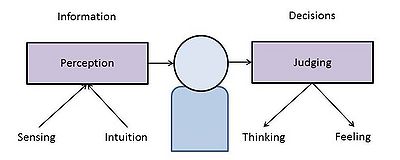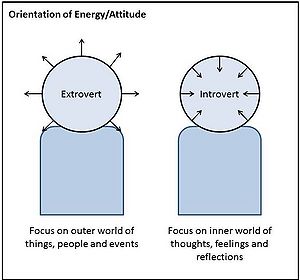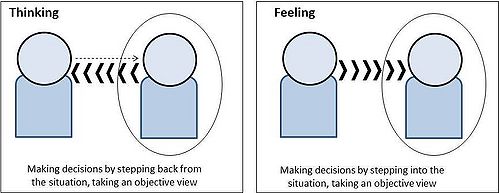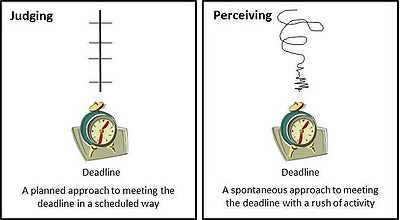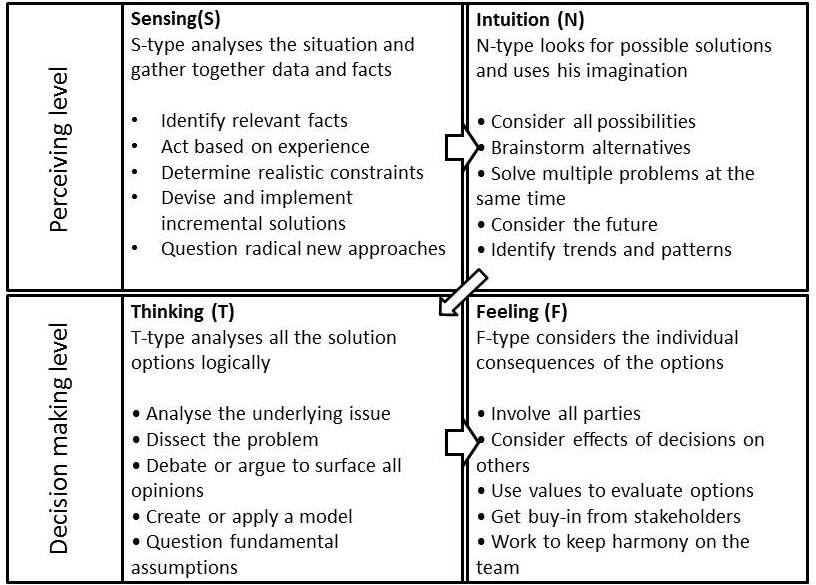Group Dynamics and Personality Types
Developed by Jesse Pörzgen
Contents |
Introduction
The three major characteristics and issues in project, program and portfolio management are complexity, uncertainty and human behaviour. This article is focusing on human behaviour within an organisation and elaborates on the behaviour of groups and individuals.
The number and variety of systems and their relationship and dependencies have grown and hereby increased the complexity of projects; for instance in construction, business development, production or technology development. This development entails the need of a broad knowledge, which has increased the focus on project groups with interdisciplinary expertise. These modern working processes of temporary project groups have renewed the attention on group dynamics and methods of group formation, in order to assign successful project groups with high performance.
To manage or work within a temporary project group effectively, is it important to understand the group members and their behaviour of perception and judging; how the different group members are taking in information and making decisions. Every person has a certain way of behaviour and utilisation of their brain, and it is important to understand how to make use of these skills and how to interact with different team members. Furthermore is it as a manager inevitable to know how groups are developing and how the members are interacting with each other in the different stages of group development. With this knowledge it is possible to form good teams and assigning them to the right tasks, not just based on their expertise, but also on their individual profile and behaviour.
This article will clarify group characteristics; explain the processes within a group and the stages it is running through in the development. Furthermore will this article take one more step in and look on the different personality types a group can contain, based on the theory from Carl Jung and Myers Briggs, and discuss the interrelation between the group dynamics, development and the understanding of behaviour of the team members. This article is an application-oriented overview.
Groups and Group Processes
Groups are systems that create, organise, and sustain interaction amongst the members. The main purpose of teams is to make decisions; there will be a discussion of decision-making and then an examination of the process within teams when they are making decision. This group process is the interaction of individual members of a team different than the sum of the individuals that make up the team. It is crucial to know how to set up and manage a project group so the contribution to the organisation of the team is greater than the sum of the individual input.[1]
According to the Business Dictionary a working group is defined as following;
“A collection of individuals that come together to achieve a stated objective. In a business context, a working group might involve people from different divisions or even companies that are collaborating on a project that requires their particular expertise or time."[2]
Different definitions of a group are referring to a group of people with collective fate or a group of people with face-to-face interaction. Furthermore, the way a group evolve is very essential part of the group definition. Sets of relationships are developing in the grouping process and people begin to adopt certain roles within the group, for example the chair, the secretary and a social worker who looks after the pattern of relating in order to prevent or resolve interpersonal conflicts.[3] A group will have more information when the information of its individuals is pooled and we will usually expect that groups will solve more problems or produce better solutions. [4]
Marjorie E. Shaw’s article “A Comparison of Individuals and Small Groups in the Rational Solution of Complex Problems” (1932) was a highly influential social psychological empirical study on small group performance and has shown that more intellectual problems will be solved by a group than if individuals is set to solve the problem. However, the group process will take longer time in order to achieve a solution, which is caused by social loafing in the group development and the complexity of the communication between the group members, as they interact in seeking an solution. As the cost and the time taken is higher than the individual working process, the organisation should only use groups when the decision does not have to be taken very quickly and where the benefits to the organisation of good decisions outweighs the extra cost.[4]
Group Dynamics
Group Dynamics is a system of behaviours and psychological processes occurring within or between groups, referring to the intragroup and intergroup dynamics. The study of group dynamics can be useful in understanding decision-making behaviour, tracking the spread of diseases in society, creating effective therapy techniques, and following the emergence and popularity of new ideas and technologies. [5] In terms of project management is the understanding of group dynamics important and useful to manage a project groups and react on challenges properly.
Kurt Lewin was the first one who used the phrase group dynamics, which describes the way groups and individuals act and react to changing circumstances and the influential interpersonal processes that take place in groups. The underlying processes in the group development give rise to a set of norms, roles, relations, and common goals that characterize a particular social group. [6]
There are many models used to describe team dynamics. Many of them describe the psychological aspects of group dynamics such as:
- Group dynamics (Lewin) which considers how people interact and the common perceptions that arise within a group.
- Psychoanalysis (Freud and Bion) which is concerned with the (natural) defensive behaviours of team members.
- FIRO/Human Elements (Schutz) which considers the compatibility between people using behaviours of inclusion, control, openness, and how those behaviours relate to inner feelings of significance, competence, and likeability.
- The Tuckman model considers Four Stages of Team Development - forming, storming, norming, and performing.
- Team Roles such as MTR-i or Belbin, Designing Project Teams, examine how team performance is related to nine psychological roles taken by different team members.
- Personality type theories, such as Myers Briggs, Disc, Herrmann Brain Dominance, consider how the different preferences of team members affect their interactions and team performance.
- Team Islands and In/Out groups, showing how sub-teams can form as a result of members having different characteristics or being separated by a geographical boundary
Problems occurring from bad group dynamics can come from weak leadership, too much deference to authority, blocking, groupthink and free riding, among others. To tackle these obstacles and to strengthen your team's dynamics it is important to know your team, define roles and responsibilities, break down barriers and focus on communication.[7] To do so it is important to understand some of the fundamental models mentioned above. This article is therefore explaining the development of a group on behalf Tuckmans theory, and clarifies what type of persons the team is consisting of by utilizing Myers-Briggs Type Indicator.
Group Development
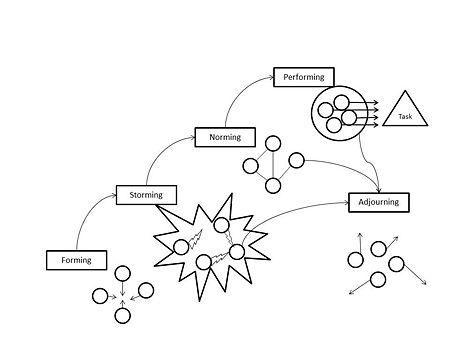
Groups are living system and under constant development, which are patterns of growth and change that emerge across the group´s life span. A holistic perspective on groups prompted researchers to examine how a group, as a unit, changes over time. [3]
Bruce W. Tuckman’s theory of group development, for example, assumes that most groups move through the five stages[8] summarized in figure 1 .
Forming The first stage of the group development is the forming stage, where the group members become oriented toward one another. People’s behaviour is motivated by the desire of being accepted by the rest members of the group, without generating conflicts and trying that everything works as planned.
Storming In next stage is storming, where disagreements and conflicts surface in the group as members vie for status and the group sets its goals. These conflicts between members will derive on the rising of the most appropriate team leader although at first it might not be accepted by all members. The group members are especially susceptible in this stage.
Norming These conflicts of the storming phase will subside when the group becomes more structured and standards emerge in the norming stage. The group establishes a common understanding of the goals, their approach and how they should interact with each other.
Performing In the performing stage, the group moves beyond disagreement and organizational matters to concentrate on the work to be done. The group continues to function at this level until a change in the group occurs, which can lead to a new storming and norming phase.
Adjourning The adjourning stage is describing the behaviour when a group member is close to leaving the project or when the project group is disbanding. [8]
Groups also tend to cycle repeatedly through some of these stages, as group members strive to maintain a balance between task-oriented actions and emotionally expressive behaviours [9]. A group, in a real sense, is alive: It acquires energy and resources from its environment, maintains its structure, and evolves over time.[3]
As a project manager it is important to understand the development of a group to react appropriate in the different faces, accelerate its development and achieve the performance stage. To ease the storming stage, accelerate the norming stage and increase the performance of the team, is it important to understand the behaviours and personality types of the different individual group members. There are different methods to verify the different personality types. One of the most accepted and applicable method is based on the theory of Carl Jung and Meyers-Briggs, which will be elaborated in the following sections.
Myers-Briggs Type Indicator - MBTI
The Meyers-Briggs Type Indicator assessment is a psychometric questionnaire in order to identify the different personality types of people.[10] The questionnaire is created by Katharine Briggs and Isabel Briggs Myers, and is based on Carl Jung’s complex theory of psychological types. The MBTI provides a framework to measure the preferences in how people perceive the world and make decisions. The results identify valuable differences of human behaviour, which can be the source of much misunderstanding and miscommunication. [10] [11] The MBTI is based on four principal psychological functions by which we experience the world. According to Carl G. Jung's theory of psychological types, people can be characterized by their preference of the general attitude (Extrovert, Introvert) and the four function of perception and the function of judging (Sensing, Intuition, Thinking and Feeling) [12] [13]
- Attitude: Extroverted (E) vs. Introverted (I)
- Perception: Sensing (S) vs. Intuition (N),
- Judging: Thinking (T) vs. Feeling (F)
The three areas of preferences introduced by Jung are dichotomies (i.e. bipolar dimensions where each pole represents a different preference). Isabel Briggs Myers proposed to see the judging-perceiving relationship as a fourth dichotomy influencing personality type [10]:
- J-P relationship: Judging (J) vs. Perceiving (P)
Figure 2 are illustrating the different way of basic mental processes of information and decisions, which Myers-Briggs and Jung´s theory is explaining.
The following subsections are describing and illustrating the four different dichotomies, according to CPP (Exclusive publisher of MBTI)
The Attitude
Extroversion People who prefer extroversion focus their energy and attention outwards and are interested in world of people, things and events. These type of persons are aware of who and what is around them, enjoy meetings and talking with new people. They are friendly, often verbally skilled and easy to know. Extrovert people tend to speak out easily and often at meetings, and may not be aware of what is going on inside themselves.
Introversion People who prefer introversion focus their energy and attention inward and are interested in the inner world of thoughts, feelings and reflections. They are usually very aware of their inner reactions and prefer to interact with people they know. These persons are often quiet in meetings and seem uninvolved and are often reserved and harder to get to know. Introvert people may not be aware of the outer world around them.
The Perception
Sensing People who prefer sensing prefer to take in information using their five senses – sight, sound, feel, smell and taste. They see and collect facts and details, and are practical and realistic. People with the preference of sensing take one step at a time and are specific and literal when speaking, writing and listening. They live in the present, dealing with the here and now.
Intuition People who prefer intuition go beyond what is real or concrete and focus on meaning, association and relationships. They see patterns, possibilities, connections and meaning in information. People who prefer intuition are conceptual and abstract. They speak and write in general metaphorical terms and live in the future with possibilities.
The Judging
Thinking People who prefer thinking make their decisions based on impersonal, objective logic. They use logic to solve the problem, assess pros and cons. Thinking people focus on problems, tasks, facts and the principles, and are good at analysing a situation. They may overlook the personal impact of decisions their emotions or those of others
Feeling People who prefer feeling make their decisions with a person-centered, value-based process. They use their personal values to understand the situation and focus on the values of the group or organisation. Feeling people are good in understanding people and their viewpoint, and concentrate on relationships and harmony. They may overlook logical consequences of individual decisions.
The Judging and Perceiving Relation
Judging People who prefer judging want to be organised and orderly, and look at the world and see decisions that need to be made. Judging people like to make plans, follow them and get things settled and finished. Their environments have to be structured and with clear limits. They enjoy being decisive and organising others. People who prefer judging handle deadlines and time limits comfortably and plan ahead to avoid last minute rushes.
Perceiving People who prefer Perceiving seek to experience the world and not to organise it. They look at the world and see options that need to be explored. Perceiving people like to respond resourcefully to changing situations and like to leave things open, gather more information and be flexible towards their environment, why they don´t like to make decisions. They dislike rules and limits and tend to think that there is plenty of time to do things, which leads that they often have to rush to complete their task at the last minute.
The 16 MBTI types
All possible variations of preferences in the four dichotomies above contain 16 different combinations, or personality types. These personality types are representing which of the two poles in each of the four dichotomies dominates in a person. Each personality type can be assigned a four letter acronym of corresponding combination of preferences. Myers-Briggs Foundation are presenting a detailed description of the behaviour of the 16 different personalities types. The table below are reflecting the key elements of different types and their role, which is conducted of the description and tables of the types.[11]
| Personality Types | Description | Role | Key Elements |
|---|---|---|---|
| ISTJ - introvert sensing with extrovert thinking | Doing what should be done | Inspector
Most Responsible |
|
| ISFJ - introvert sensing with extroverted feeling | A high sense of duty | Protector
Most Loyal |
|
| INFJ - introverted intuition with extroverted feelings | An inspiration to others | Counsellor
Most Contemplative |
|
| INTJ - introverted intuition with extroverted thinking | Everything has room for improvement | Mastermind
Most Independent |
|
| ISTP - introvert thinking with extroverted sensing | Ready to try anything once | Operator
Most Pragmatic |
|
| ISFP - introverted feelings with extroverted sensing | Sees much but shares little | Composer
Most Artistic |
|
| INFP – Introverted feelings with extroverted intuition | Performing noble service to aid society | Healer
Most Idealistic |
|
| INTP – Introverted thinking with extroverted intuition | A love of problem solving | Architect
Most Conceptual |
|
| ESTP – Extroverted sensing with introverted thinking | The ultimate realist | Promoter
Most Spontaneous |
|
| ESFP – Extroverted sensing with introverted feeling | You only go around once in life | Performer
Most Generous |
|
| ENFP – Extroverted intuition with introverted feeling | Giving Life an extra squeeze | Champion
Most Optimistic |
|
| ENTP – Extroverted intuition with introverted thinking | One exciting challenge after another | Inventor
Most inventive |
|
| ESTJ – Extroverted thinking with introverted sensing | Life´s administrator | Supervisor
Most Hard Charging |
|
| ESFJ – Extroverted feeling with introverted sensing | Host and hostesses of the world | Provider
Most Harmonizing |
|
| ENFJ – Extroverted feelings with introverted sensing | Smooth talking persuader | Teacher
Most Persuasive |
|
| ENTJ – Extroverted thinking with introverted intuition | Life´s natural leader | Field Marshall
Most Commanding |
|
Applications and Benefits from MBIT
Myers Briggs Type Indicator is one of the most popular and respected personality type tools in the world. The tool helps people easily understand why differences arise at home and in the workplace. It is an easy and understandable framework which helps to build relationships and teams. Myers-Briggs Type Indicator leads to understand your type, to use differences as an asset and to help better work together.[11] MBTI is a method to verify and understand human behaviour and therefor also applicable in project, program and portfolio management.
The MBTI is used in practice to harmonize working styles, improve teamwork, support changes and optimize communication procedures. The MBIT assessment has been utilized in education, career consulting, personal and spiritual growth, family relationships and health care delivery. This tool had also a great impact in organizational development through building high performing teams, developing leaders, managing professional development and performance improvement, boosting retention, implementing change, developing sales forces and improving customer service.[13]
The MBTI model is particularly useful for[14]:
- understanding and developing yourself
- understanding and developing others
- understanding what motivates others
- understanding others' strengths and weaknesses
- working in teams - by ensuring that all relevant necessary capabilities are represented in the team allocating and agreeing tasks and project responsibilities
- agreeing roles and development with others and for oneself
The assignment of temporary project teams in one of the main tasks in program or portfolio management. MBTI gives you not the power to assemble the perfect high performance teams, but it can help to analyse the different team members or team constellations on their strength and weakness on forehand and assigning them according to its task. Furthermore can it be a helpful tool to create a more constructive and functional communication in the group, which can lead to a better performance of the team.
The process of the group development, in terms of B. Tuckman’s 5 stages can also be affected by an implementation of the MBTI, as the awareness of the behaviour and communication between the group members can accelerate the storming and norming phase.
The rule for teams or project groups to remember is that people find it easier to interact with people of the same type. However, effective problem-solving is particularly possible if the team members exhibit different preferences, and they are used for purpose of teamwork.[15] The following section will elaborate the use of MBTI in a problem solving process.
Team problem solving with MBTI
Appropriate problem solving techniques should be employed, making use of knowledge derived from analysing the personality profiles of team members. Research on the relationship between personality characteristics and problem solving suggests that consideration of individual differences is important both to understanding and enhancing the problem-solving process[16]
Team problem solving involves collecting information and then making a decision—the two behaviours that form the core of psychological type. Isabel Myers believed that the best way to solve a problem is to use the four type functions deliberately and in a specific order: Sensing, Intuition, Thinking, and Feeling. There has been presented a best practice to use the preferences for effective problem solving, which also is illustrated in figure 3[17].
Discussion
The MBTI is a good tool in order to identify a person´s personality type to improve the communication and the interaction between people. Its usability is proven by its world wide application in all kinds of areas and industry sectors. The theory of Myers-Briggs has 16 personality types, and there is place of discussion if these 16 boxes are appropriate and a sufficient granularity to define each individual’s type. If the description of the type as indicated by the MBTI doesn't sound right to the individual, it may not be. The MBTI results suggest your probable type, based on the choices you made when you answered the questions. Therefore, is the type not unchangeable, and is open to personal interpretation. The MBTI type doesn't describe everything and human personalities are much more complex. Instead, MBTI scores show how clearly a particular preference was reported in the questionnaire. They don't measure skills, or ability, or degree of use, but they may help us to understand a person better – or even match a job with a worker.
Myers Briggs theory and the MBTI model is a method for understanding personality and preferred modes of behaving. It is not a measurement of intelligence or competence, emotional state or mental stability or maturity, and must be used with great care in assessing aptitude for jobs or careers: people can do most jobs in a variety of ways, and the MBTI gives little or no indication of commitment, determination, passion, experience, ambition etc., nor 'falsification of type', all of which can have a far greater influence on personal success than a single personality test.[14]
The attitude toward taking the test can make a difference, and the questions can be irritatingly context-free. Questions on preferring specific plans or schedules may be answered differently if you think in terms of vacation plans or software release plans.
In consideration of the problem solving model, will the team have less interest in, and spend less time on, behaviours associated with Feeling and Sensing. In fact, it may short-circuit the Z-model process and use only the Thinking and Intuition steps, which can be noticed of the group dynamics of team meetings. However, if the team neglects to use Feeling, it may miss what is most important to its customers or clients. If it neglects to use Sensing, it may miss relevant facts that it needs to solve problems and make decisions. Team performance may suffer if all four functions are not considered.
References
- ↑ P.D. Kitchin (2010).An Introduction to Organisational Behaviour for Managers and Engineers (UK:Elsevier)
- ↑ BusinessDictionary.com,http://www.businessdictionary.com/definition/working-group.html#ixzz3JtrozC9d]
- ↑ 3.0 3.1 3.2 3.3 Forsynth, D.R.(2006).Group Dynamics, Fourth Edition, Chapter 1 (USA:Thomson Wadsworth)
- ↑ 4.0 4.1 M.E. Shaw (1932).A Comparison of Individuals and Small Groups in the Rational Solution of Complex Problems. American Journal of Psychology 44,419-504
- ↑ Backstrom, L.; Huttenlocher, D.; Kleinberg, J.; Lan, X. (2006). "Group formation in large social networks",ACM SIGKDD international conference
- ↑ Wageman, R. (1995). "Interdependence and Group Effectiveness". Administrative Science Quarterly 40 (1): 145–180.
- ↑ Mind Tools HP(2014), Group Dynamics, http://www.mindtools.com/pages/article/improving-group-dynamics.htm, UK
- ↑ 8.0 8.1 Tuckman, B. W. and Jensen, M. A. (1977) Stages in small group development revisited. Group and Organisation Studies
- ↑ Bales, R. F. (1965) ‘The equilibrium problem in small groups’ in A. P. Hare, E. F. Borgatta and R. F. Bales (eds.) Small Groups: Studies in social interaction, New York: Knopf
- ↑ 10.0 10.1 10.2 Myers, Isabel Briggs with Peter B. Myers (1995) [1980]. Gifts Differing: Understanding Personality Type. Mountain View, CA: Davies-Black Publishing.
- ↑ 11.0 11.1 11.2 MBTI basics, The Myers-Briggs Foundation, 2014,http://www.myersbriggs.org/
- ↑ Jung, C.G. (1971). Psychological Types. London: Routledge & Kegan Paul. (Collected Works of C.G. Jung, Vol. 6)
- ↑ 13.0 13.1 MBTI today HP, 2014, http://mbtitoday.org/about-the-mbti-indicator/#sthash.QfOsoH6V.dpuf
- ↑ 14.0 14.1 A. Chapman (2014) Personality theories, types and tests, Business Balls HP, Leicester, England, http://www.businessballs.com/personalitystylesmodels.htm
- ↑ 15.0 15.1 T.Lorenz & Stefan Oppitz (2010) Enhance your profile through Personality - On basis of the Myers-Briggs Type Indicator(R) (MBTI) Instrument, 3. edition, Gabal Verlag
- ↑ Huitt, W. (1992). Problem solving and decision making: Consideration of individual differences using the Myers-Briggs Type Indicator. Journal of Psychological Type, 24
- ↑ 17.0 17.1 Myers, I. (1980). Gifts differing. Palo Alto, CA: Consulting Psychologists Press.
